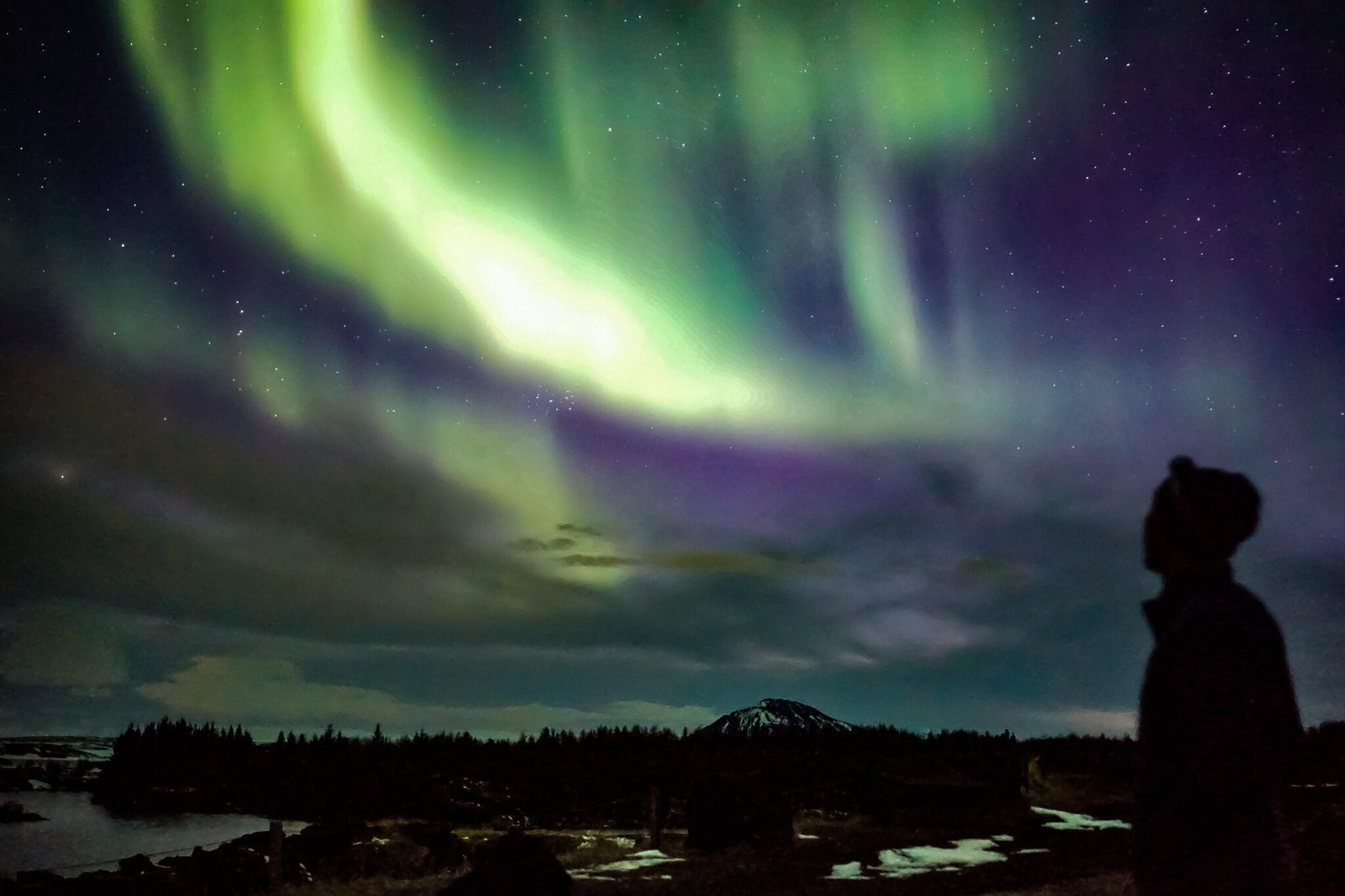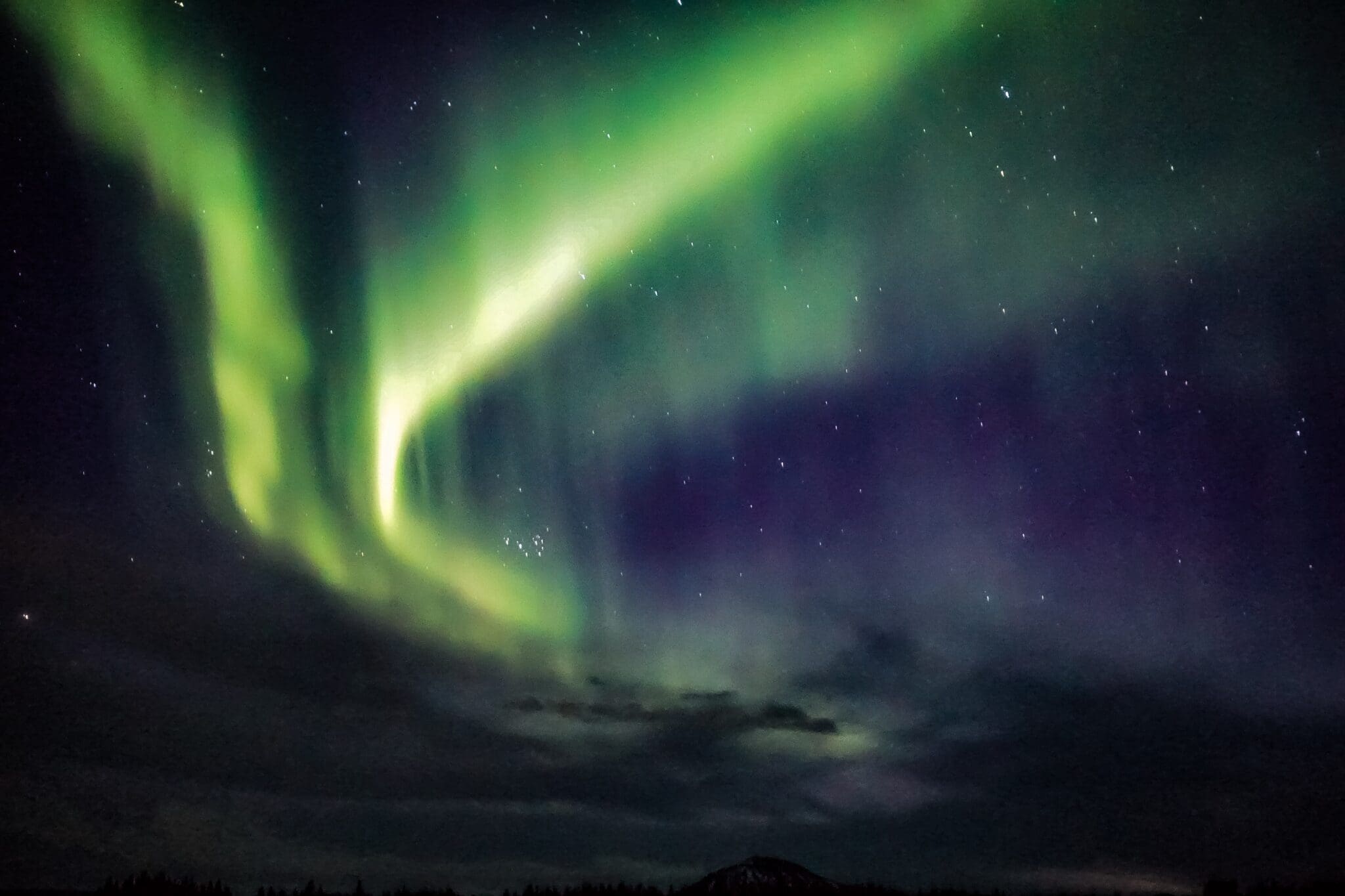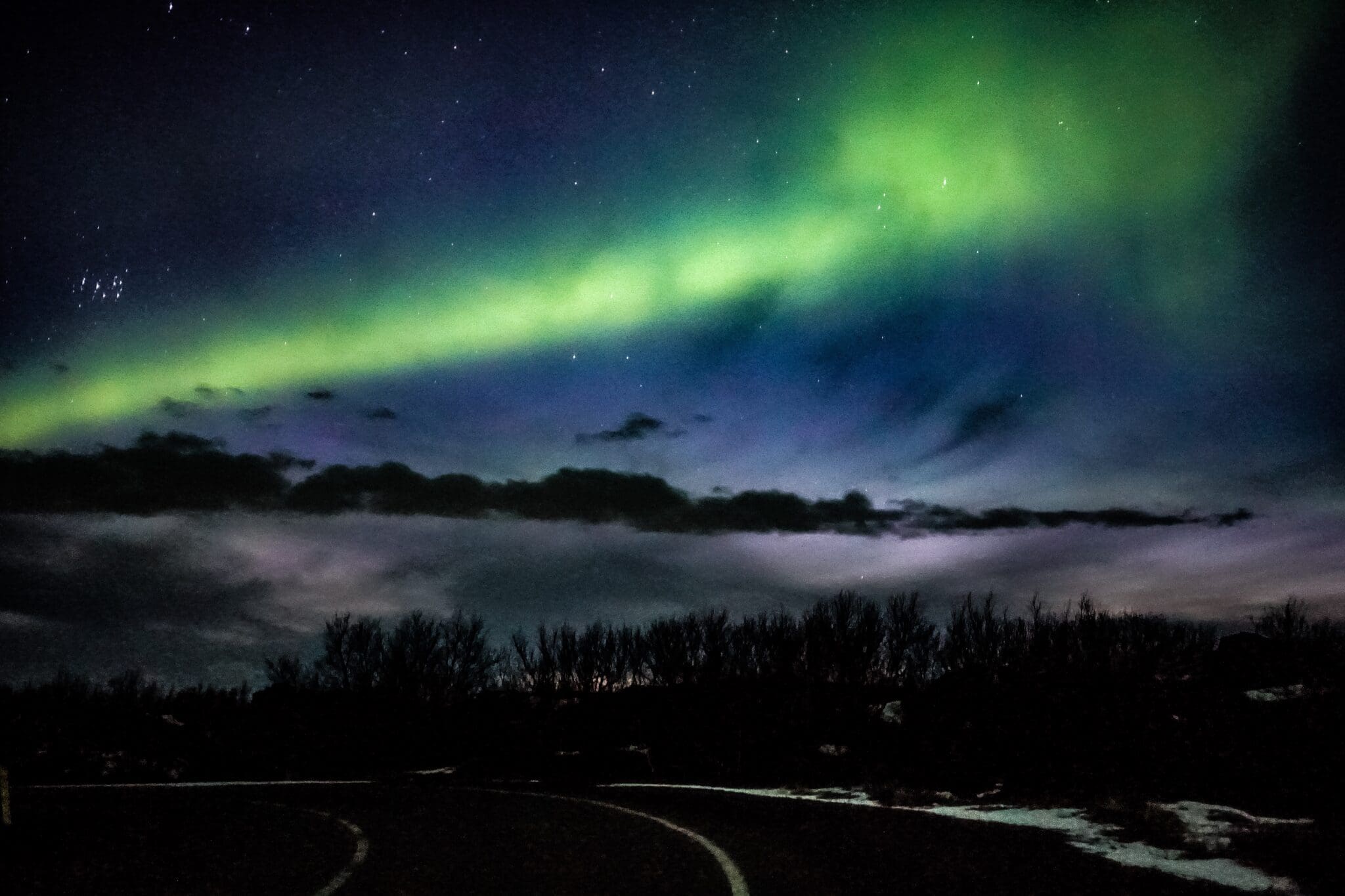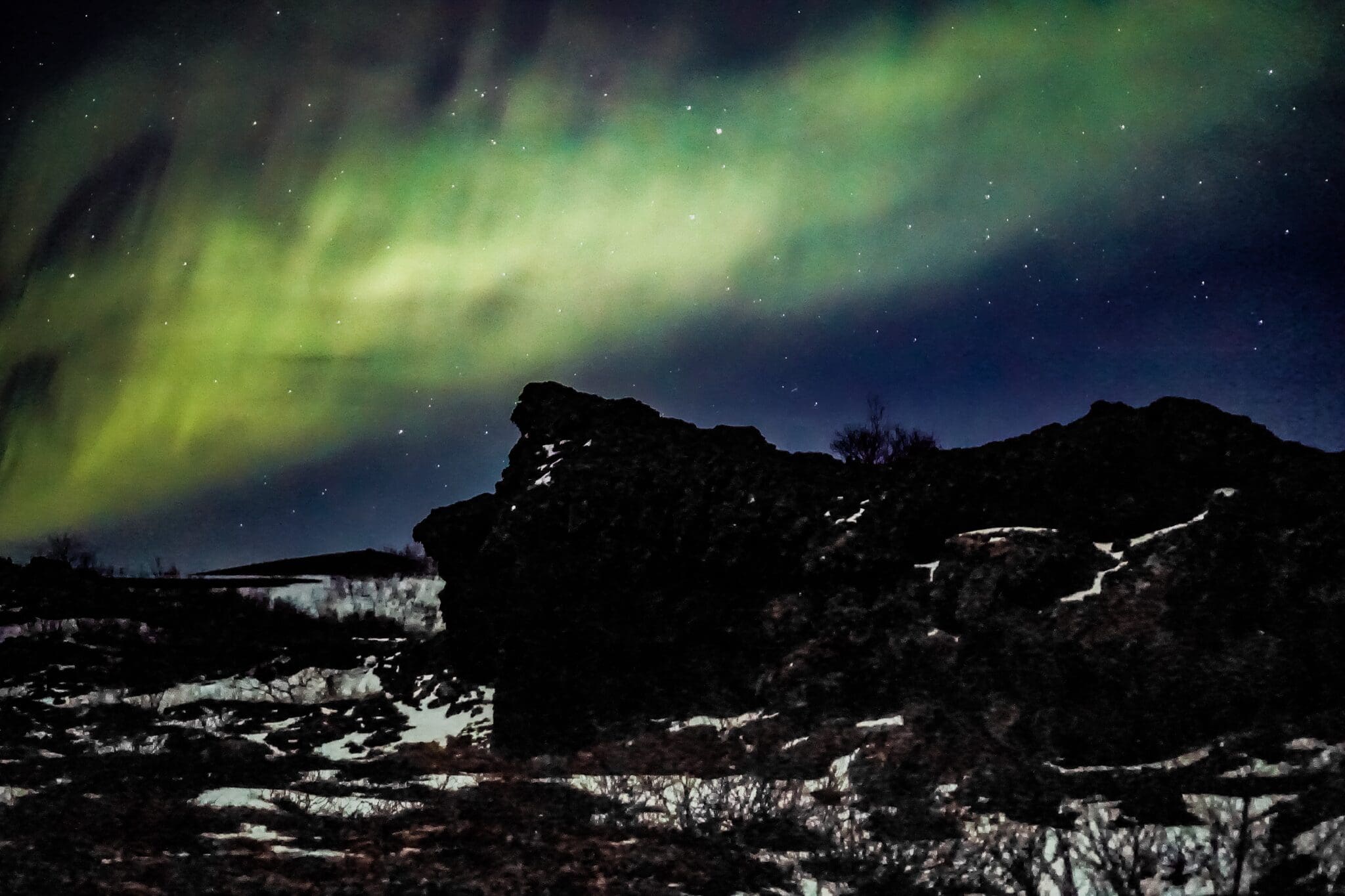Day 2: Catch the Northern Lights Show in Iceland
One of my ultimate bucket list items was to experience the Northern Lights in Iceland. Imagine peering up to the heavens to witness different colors of lights dancing across the crisp night skies of an Arctic winter. They’re one of nature’s unforgettable shows where several factors come into play in order to catch a front seat view including the right conditions, the right location, & the right time. Good planning, patience, & a fair amount of luck are needed to see the elusive Aurora Borealis.

Please note: This post contains affiliate links.
This means that, at no extra cost to you, I may receive a small commission if you make a purchase through my affiliate link.
You may read my full disclosure policy here.
Akureyri
Akureyri is the unofficial capital of the North & the second largest city in Iceland. With a population of 18,000, it has the similar laid-back vibe as Reykjavík & surrounded by the same natural beauty all around. It is also the gateway to the spectacular sights of the North, notably the Mývatn region &, of course, the Northern Lights.
Normally when I come upon a new tourist town, I would spend hours wandering into every cute boutique & coffee shop. But with the excitement for our highly anticipated activities, we reserved our energy & kept it low-key. This time we stayed at the K16 Apartments. Our unit was fully furnished with a bedroom, living room, dining area, & kitchenette. Every room was well stocked with all the necessities for guaranteed comfort. It was the perfect place to rest up for the night before heading back out to catch the main event.

What Are the Northern Lights?
The Northern Lights, also known as the Aurora Borealis, is one of the most spectacular astrological shows. The natural phenomena occurs when the sun releases solar flares that travel through space in the form of electrons. The earth’s geomagnetic field acts as a shield & the particles collide violently with the gas atoms in the upper atmosphere. This causes colorful flares to wrap around the atmosphere & separate at the poles. What results is an amazing light show that can be witnessed from the extreme hemispheres including Iceland!
“If people sat outside & looked at the stars each night, I’ll bet they’d live a lot differently.”
Calvin & Hobbes
When & Where to Catch the Northern Lights Show
In general, the best time to view the Northern Lights is from September through March. The summer season, with its longer days & the “Midnight Sun,” makes it difficult to see the lights, as the skies don’t get dark enough. Serious stargazers who plan to visit Iceland solely for the Lights should go during the Autumn Equinox (September 21 to 24). During this period, the Earth tilts at such an angle that allows solar winds & charged particles to get caught in the magnetic field.
When searching for the Aurora, clouds can become your number one enemy. Even if the magnetic activity is predictably high, cloud cover can prevent you from seeing anything beyond it. We kept checking Iceland’s national weather website to stay up-to-date with visibility levels. Here you will find a map with green representing clouds & white as clear skies. For reference, an aurora forecast with a KP index of 3 or greater will give you a better chance of catching the show.
Light pollution can also make it difficult to view the Northern Lights as it will dilute the brightness of the skies. It is best to drive out to the remote areas of Iceland, away from any major cities. Same idea applies to a full moon as its glow could take over the skies.

My Camera Settings
Knowing that our iPhones would not be able to capture the Northern Lights (& upon expert recommendations from our photography friends), we decided to invest in a nicer camera, the Sony Alpha a6000 Mirrorless. Please note that the photos featured in this post were taken with little experience & less than optimal amount of practice. Fortunately, we were able to utilize the following tips to bring out the best in them:
- Have your camera gear ready & adjust your settings during the day. Set it to manual mode & focus to infinity (∞), otherwise it will not capture a sharp image in the dark.
- Set your aperture (F-stop) to the lowest number as your lens can go, preferably 2.8 or 4. Using the widest aperture allows you to capture as much light as possible.
- Play around with the shutter speed. The faster the lights are moving, the shorter the shutter speed should be. For average moving auroras, we found a long exposure of 15-25 seconds to be sufficient.
- Experiment with the ISO settings to help reduce any noise in your photos. The number will depend on how bright the aurora is. Just remember, the higher the ISO, the more “graininess.”
- There will be long periods of waiting, so bring a sturdy tripod as well as a shutter release remote. If your camera does not come with a remote, you can use a built-in timer. In order to take a focused photo, you will need to keep your camera stable. A flashlight can come in handy, or even better a headlamp so you can remain hands-free!

Chasing the Aurora Light
We visited Iceland in early April, which was the tail end of winter so our chances were somewhat slim. However, we remained optimistic. Because the weather in the North tends to be colder & thus more stable than the South, we reserved our Northern Lights hunt for Day 2 of our Ring Road adventure.
At around 2am, we bundled up & drove deep into the arctic wilderness, far away from the city lights of Akureyri. We stopped every now & then to stare up at the starry skies for any signs of action. After what felt like hours of nothing but still darkness, we spotted a faint grey cloud out in the distance. Initially, it wasn’t as vibrant as I had hoped, but its fluid movements kept our attention & my husband began setting up his camera. A few minutes later, a green shimmer began to grow in intensity, as a shade of purple started to swirl in. It was as if we were watching a live watercolor being painted onto a black canvas sky. What we then witnessed was a spectacular display of lights. In that moment, my heart filled with joy & wonder that nearly drove me to tears.
In truth, many people don’t realize that the photos featured on social media & the internet are a bit exaggerated (& sometimes overly photoshopped). With the naked eye, the aurora appears far more muted & the colors are rather dull. However, with the right equipment & enough patience, you can uncover the hidden colors of what the Northern Lights is greatly known for.

Angella’s Travel Tips
- Scout out your photoshoot location ahead of time. It will be difficult to chase the Lights while driving in the pitch darkness of backcountry. Try to locate a subject, such as a mountain or a bright star, to add some drama to the photo.
- Bring several spare camera batteries as cold temperatures can make them drain faster. Also pack extra memory cards, since you can never take too many pictures in hopes of capturing that perfect shot.
- Dress in layers & activate hand warmers to keep inside your pockets. You don’t want your fingers to freeze & not be able to press that camera shutter!
- Don’t forget to prepare snacks & hot beverages to keep your body sustained as much of your energy will be spent shivering in the cold.
- Always remember that the Northern Lights are a natural phenomena. To experience this elusive show is simply a matter of luck. Because of the unpredictable weather conditions in Iceland, it can be a huge gamble that most people don’t anticipate. While these tips may increase your odds, keep in mind there is still a real possibility that you may not get to see it. But do not get discouraged as there are many other natural wonders to see in Iceland!
“Remember to look up at the stars & now down at your feet. Try to make sense of what you see & wonder about what makes the universe exist. Be curious. And however difficult life may seem, there is always something you can do & succeed at. It matters that you don’t just give up.”
Stephen Hawking


Ayishia
October 21, 2019 at 11:38 amSuch a fantastic post! I was supposed to make this trip last month but it didn’t end up happening. I’m kind of glad now after reading this because I was relying on using my iphone to get great shots. I’m hoping to gift myself a camera for Christmas so maybe I’ll figure out how to use it in time for the next go round.
Angella
October 22, 2019 at 3:14 pmOh, you have to make it out to Iceland…now that the winter weather starts around this time, the Northern Lights show will begin soon too! Definitely take photos with a mirrorless camera…not sure if the new iPhones are advanced enough to capture them to the fullest! You will have a great time, nevertheless!